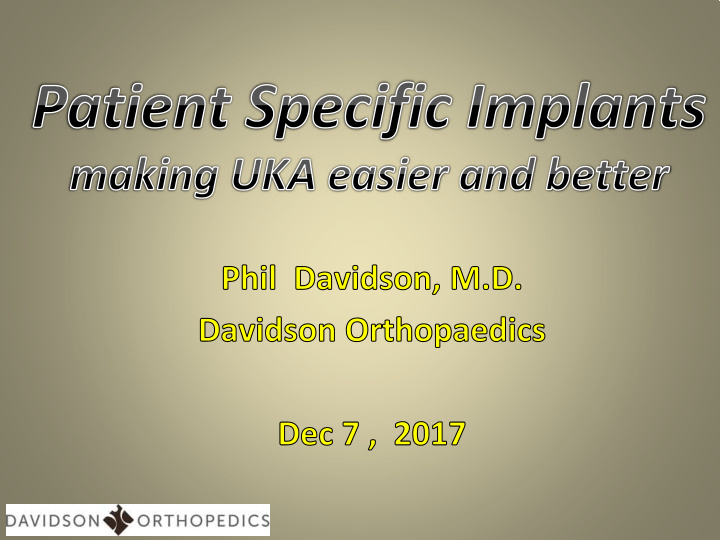



No conflicts
OUTLINE • Unicompartmental Joint Resurfacing – – Decision Making • Onlay Arthroplasty • Patient Specific Jigs and Implants – Accuracy – Results • Alternative Techniques – Robotics, Mobile bearing, Legacy tech
Biologic or Prosthetic Resurfacing ???? Key decision making point • Multifactoral decision – Lesion/Cartilage nearby – Patient Factors – Age (biological) – Comorbidities – Joint Status – Resources
Transitional thinking from biologics to prosthetics • Once progress in resurfacing algorithm from bio to prosthetic need conceptual framework 1. Inlay 2.Onlay 3. Bone sacrificing (traditional TKA)
Why Consider Resurfacing? 1. Need for bridging or intermediary procedure in younger patients 2. Preserve healthy anatomy in older patients • Increased burden of US TKA --- 4M with TKA, 1.5M between 50- 69 yrs – Weinstein, JBJS March, 2013 • 15% of total knee patients have severe or extreme persistent pain three to four years post op. – Wylde V, Pain 2011 19% of middle aged patients were entirely satisfied with the outcome of their total knee replacement Bourne et al., Clin Orthop Relat Res 2010
Onlay Knee Resurfacing using Patient Specific Jigs and Implants Theoretical advantages • Line-to-line bone conformity of components to bone • Can preop AND intraop manipulate/correct malalignment and malangulation • Minimize bone resections, no resection distal femur • Simplify and speed procedure, potentially more predictable outcomes • Facilitate optimal load transfer to cortical bone, possible/theoretical greater longevity • Lesser bone cuts AND better fit, theoretically longer lasting, facilitate easier and/or fewer revisions
Onlay Resurfacing Arthroplasty with Patient Specific Jigs & Implants Practical: • Digitize limb, including size and alignment PRE-OP – MRI or CT • Avoid intraop “fiddling” • Why not preserve subchondral bone????
Onlay Resurfacing with Patient Specific Implants & Jigs • Implants and Jigs 3D printed • More accurate fit may increase longevity • Accommodate morphologic variability, “odd sizes and shapes”
Patient Specific UKA Implants and Jigs Fit Better • Patient-specific implants vs off-the-shelf implants • Greater cortical rim surface area coverage • 77% v. 43% medially • 60% v. 37% laterally
Patient Specific Jigs and Implants ONLY good Lateral Side Option
• Tibial fit was much better in patient specific vs legacy implants – 1.0 mm mismatch vs 3.3mm mismatch p<.01 • Survivorship at mean 36 mos 97% vs 85%
• 31 patients with medial OA (27 medial knee osteoarthritis, 4 osteonecrosis) • Mean age 60 years. Minimum follow-up 17 months. One aseptic loosening needed exchange; one acute late-onset infection • • No further revisions/reoperations or complications. • X-rays showed an ideal fit of the implant with less than 2 mm subsidence or overhang in all cases. • VAS changed from 6.51 preoperatively to 1.11 postoperatively. • KSS (Knee Society Score) improved from 111.23 preoperatively to 180.61 postoperatively Functional KSS improved from mean 60.39 to 94.51. •
Tibial Component Sizing - Onlay Does size matter? Implication of mismatch • Chau R, Gulati A, Pandit H, Beard DJ, Price AJ, • Overhang of tibial tray by Dodd CAF, Gill HS, Murray DW: Tibial component overhang following unicompartmental knee >3mm occurred in 9% of replacement - does it matter? Knee 2009, Vol. Oxford UKR in series n=160 16, pp. 310 - 313. • 5 yrs post op, this group had significantly worse Oxford Knee Scores (p=.0001) than those without overhang • Don’t want to undersize tray either, risk subsidence
Excellent Fit and Alignment • Accuracy of Implant Match: – Mean: 0mm AP, 1mm Med-Lat • Slope maintained – 5 degree pre op slope unchanged • WB Fem-Tib alignment corrected – Mean preop 7 degrees varus – Mean postop 1 degree varus
Patient Specific Onlay Resurfacing
Residual cartilage subjacent to implant removed
Holes for implant pegs and cement interdigitation
Mobile Bearing… really???? • Disadvantages – Huge bone resection – Poor fit – Non anatomic • Advantages – NHS formulary – 35+ year history • VCR, pagers, cassettes
You’ve got to be kidding….. • Robot costs >1M $ • Implants are off the shelf • Marked intraop complexity • A “ work-around” for Patient Specific Jig and Implant IP
For those of you that still think the robot is the way to go…..
Patient Specific Jigs and Implants are the only way to go…. • Simpler • Faster • More Accurate • Less Cost • Longer Lasting • BETTER
Thank You phildavidsonmd@gmail.com davidsonorthopedics.com
Recommend
More recommend